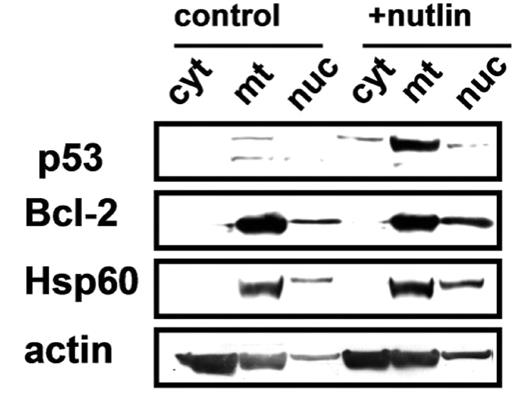Abstract
The p53 protein plays a key role in triggering DNA damage-induced apoptosis. The classical pathway of p53-mediated apoptosis involves transcriptional upregulation of pro-apoptotic proteins Puma and Noxa. However, recent studies identified a non-transcriptional mechanism, involving direct association of p53 with mitochondrial anti-apoptotic proteins Bcl-2 or Bcl-XL. We studied the relative contributions of transcription-dependent and -independent mechanisms of p53-mediated apoptosis in CLL cells in vitro. The cytotoxic drugs chlorambucil (chl) and fludarabine (flu) were used to induce p53, as was nutlin 3a, which augments p53 levels by inhibiting interaction with its negative regulator MDM2. Using differential detergent fractionation to isolate cytosolic (cyt), mitochondrial (mt) and nuclear (nuc) fractions, we found that a significant proportion (>50%) of the induced p53 was stably associated with mitochondria in cells treated with nutlin 3a (Fig 1), chl or flu. Co-immunoprecipitation studies established that p53 bound to Bcl-2. PFTα, an inhibitor of p53-mediated transcription, blocked upregulation of the known p53 targets p21CIP1, MDM2 and Puma. Surprisingly, apoptosis induction by nutlin 3a (Figure 2), chl or flu, quantified by western blot analysis of cleavage of poly(ADP ribose) polymerase (PARP), was augmented by PFTα. This observation was confirmed by morphological analysis of apoptosis. Cytochrome c release from mitochondria following p53 induction was also enhanced by PFTα. PFTα did not augment nutlin-, chl- or flu-induced killing of CLL cells lacking functional p53. Furthermore, PFTα did not augment killing by the p53-independent drug parthenolide and failed to increase apoptosis of normal T lymphocytes treated with chl or nutlin 3a. Our observations suggest that p53 induces apoptosis of CLL cells principally via its transcription-independent function, involving direct association with mitochondrial Bcl-2. p53’s transcriptional function apparently blocks apoptosis at a point between p53 association with Bcl-2 and subsequent release of cytochrome c. Therefore, therapeutic strategies aimed at blocking p53-mediated transcription may be of value in enhancing the action of agents which induce apoptosis of CLL cells via p53 upregulation.
Author notes
Disclosure: No relevant conflicts of interest to declare.



This feature is available to Subscribers Only
Sign In or Create an Account Close Modal